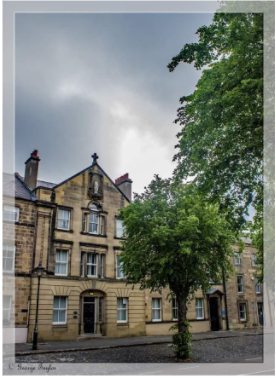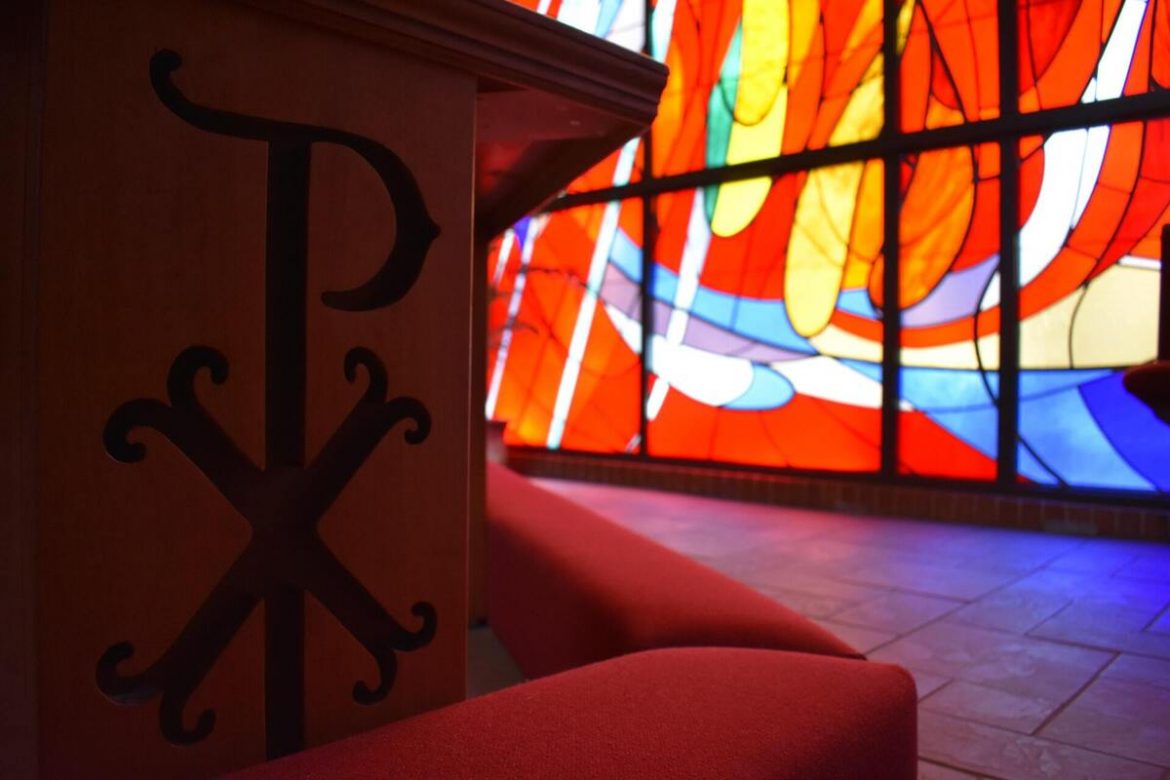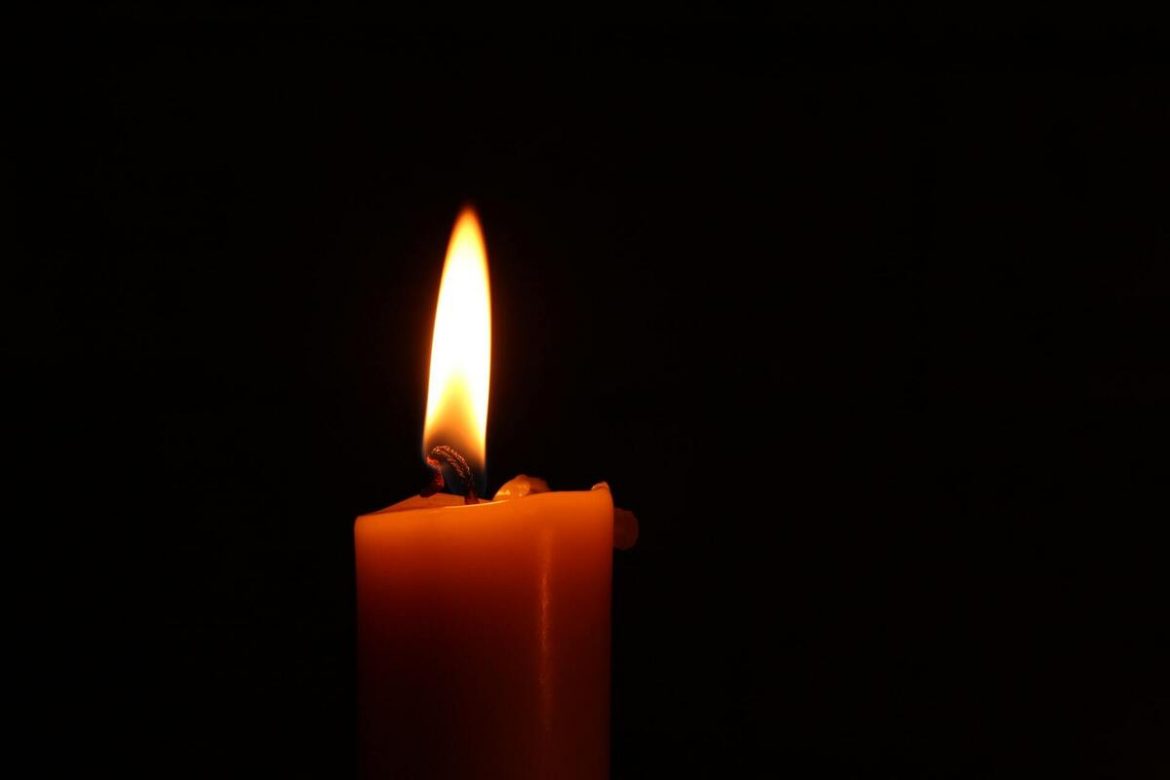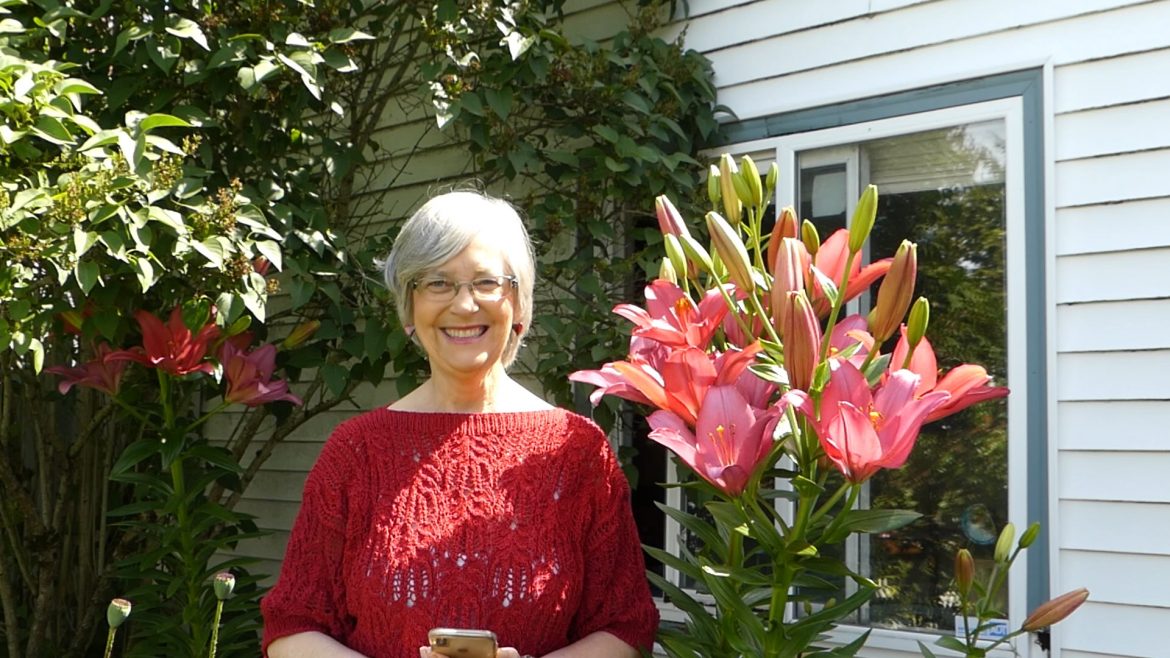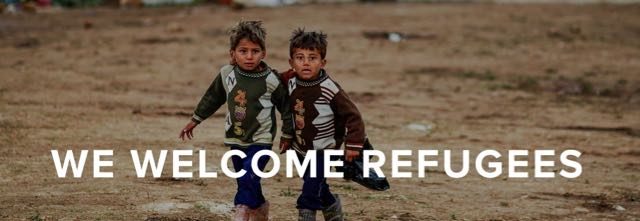by Carol Dixon
(The above photo is of the Convent of the Sisters of Mercy, Alnwick, Northumberland, Photo: © George Taylor, Used by permission)
A recent discovery of the prayer below reminded me of how different the future became in a way I could never have imagined as a young person growing up in a divided community and separated churches.
When I was young, my friend (also called Carol) went to the school just along the road from my school. Even though they were only a few doors along from each other, it was difficult for us to meet up as I went to the Duchess’s Grammar School for Girls, which was loosely affiliated to the Church of England whereas her school was a Roman Catholic Convent School run by the Sisters of Mercy and in the late 1950s & early 60s it was not the done thing to meet up with someone from a different denomination. Since my music teacher taught at the Convent School and my piano exams were held there, it wasn’t such a mysterious place to me and I didn’t feel the same kind of apprehension and uncertainty as some of my schoolfellows on entering the building for the exam because my friend went there especially as she had assured this Presbyterian that the statues were ‘nothing to worry about’.

Statue of Mary, Alnwick Convent, Photo: © George Taylor Used by permission)

photo credit: Theoliane under SA 3.0 on Wikipedia.com
Some years later when our children were young we visited the Abbaye de Ste. Sauveur le Vicomte which I knew from my friend was the Mother House of the Sisters of Mercy. We approached the large door and rang the bell and I explained in halting French that we came from Alnwick in Northumberland and the nun immediately recognised the name of the town where their teaching order was based in the UK. Even though we weren’t Catholics we received a wonderfully warm welcome and one of the nuns scurried off to find a very ancient Irish sister who was delighted to have the opportunity of speaking to English people (in a broad Irish accent!) On returning home I was able to share the story with my friend Carol and other Christians at the Ecumenical prayer group to which we both belonged – something which would have been impossible 20 years earlier when we were at school. How much things had changed in two decades and we rejoiced at the freedom we now had to share our faith together across many different denominations.
When I found a wonderful prayer below written by one of the Sisters of Mercy it reminded me of how the divisions of the past have healed and it really spoke to me in our current situation when we don’t know what the future will bring.
A Prayer For Uncertain Times
God of infinite mercy, hear our prayer!
In this time of bewilderment and fear, we ask you to give us the courage to take care of one another as Jesus did. For those who are ill, especially those who are frightened and alone, for those who cannot access healthcare, for those who are homeless and lost, hear our prayer!
In the midst of our sadness and grief, we ask you to give us words to comfort one another. For those who are dying, and for those who have already died from this virus, for those who tend them and for those with no one to tend them, hear our prayer!
In the midst of our own anxiety we ask you to give us the courage to support one another as you would. For those who are unexpectedly unemployed, for employers who share what they can, for our government and financial institutions and those who lead them, hear our prayer!
In the midst of our struggle to ensure a healthy future for all who live on this planet, we ask you to give us the hope that surpasses our current understanding. For healthcare workers, spiritual leaders and our faith communities, for artists and poets, for prophets and teachers, hear our prayer!
In the midst of our growing awareness that all life on Earth is connected, we ask for the heart to respect and cherish all life. That all peoples recognize that we are all your children, hear our prayer!
We trust in you and your power working in us. Please hear and answer our prayers.
Amen!
Amen!
— Sister Cynthia Serjak —
In times of uncertainty it is good to remember Paul’s words from I Corinthians 2: 9
‘No eye has seen, no ear has heard, and no mind can imagine what God has in store for those who love him’. I find it very reassuring to know that although we don’t know what the future may bring, we can be confident that we are secure in the loving hands of our God, as Marty Haugh ‘s hymn reminds us.
by Tom Sine
Church of the Apostles in Seattle on June 14th designed to Awaken * Confront * Transform
Christine and I viewed this very moving Zoom interracial worship experience unlike anything we had ever experienced. The powerful music was drawn from rich African sources. Here is a brief sampling of some of the elements of this worship service led by Rev Ivar Hillesland and Pastor Katherine GrayBuck.
Ivar invites you to attend the Zoom Worship Experience at Church of the Apostles at 5 pm (PST).
What is offered below is a sampling of the material in this service to give you a taste of a much more interracial worship than we had experienced before. Regrettably, all we are sharing here are some segments of the worship service.
We would welcome your feedback to this small offering of this Zoom Worship Service. We will share them with Rev Ivar and Katherine.
Opening Song: A Change Is Gonna Come
Sam Cooke, Everton Bonner, John Christopher Taylor
I was born by the river in a little tent
Oh, just like a river, I’ve been running ever since
It’s been a long, a long time coming
But I know a change’s gonna come, oh, yes, it will
It’s been too hard living, but I’m afraid to die
‘Cause I don’t know what’s up there above the sky
It’s been a long, a long time coming
But I know a change’s gonna come, oh, yes, it will
And I go to the movies, and I go downtown
Somebody keep telling me, don’t hang around
It’s been a long, a long time coming
But I know a change’s gonna come, oh, yes, it will
Then I go to my brother
I’d say brother, help me, please
But he winds up knockin’ me
Back down on my knees
There been times that I thought I wouldn’t last for long
Now I think I’m able to carry on
It’s been a long, a long time coming
But I know a change’s gonna come, oh, yes, it will
Welcome
Theme Confront – (from A.C.T. Now to End Racism campaign)
Why we are commemorating 5th anniversary of Emanuel 9
The act of listening through singing the music of other cultures with humility
Reminder about white guilt
A Confessional Litany and Lament Commemorating
Nine Who Were Slain at Mother Emanuel AME Church, June 17, 2015
From ELCA resources for Commemoration of Emanuel 9
They were doing
what we are called to
as they engaged in bible study.
It was Wednesday night—
a stranger walked in,
and these people welcomed him and prayed together:
the Rev. Sharonda Coleman-Singleton, Cynthia Marie Graham Hurd, Susie Jackson, Ethel Lee Lance, the Rev. DePayne Middleton-Doctor, Tywanza Kibwe Diop Sanders, the Rev. Daniel Lee Simmons, the Rev. Myra Singleton Quarles Thompson, and the honorable state senator and pastor of the church, the Rev. Clementa C. Pinckney.
This stranger wanted to ignite a “race war,”
he said, after he shot and killed them,
denying them the very humanity he claimed for himself,
claiming rights and privileges associated with “whiteness.”
Now we are grieved, once again in pain,
burning and anguished, lamenting the horror of evil unleashed.
And so we cry out,
Have mercy, O God, have mercy on us.
Sorrow and heartache have come to us.
Death and mourning have visited us.
We feel far from you, O God, and distant from one another.
And so we cry out,
Have mercy, O God, have mercy on us.
Evil besets us in our land.
We acknowledge that our nation is socialized in ways that promote and normalize
Colonialization. We cry out against the horrors and agonies of racism.
And so we cry out,
Have mercy, O God, have mercy on us.
The privileged of our nation have benefited from practices that dehumanize indigenous peoples.
We have claimed as “discovery” lands that were not ours. These lands have been stolen and the nations, that were the original occupants of these lands, slain.
And so we cry out,
Have mercy, O God, have mercy on us.
Tribalism has led to the denial of your presence, O God.
Present generations,
the children whose ancestors were kidnapped and sold into slavery,
those forced to labor not on their own behalf,
still suffer and struggle to live in freedom
while the children of colonizers,
live out of “white privilege,”
denying the fullness of your presence in all people.
And so we cry out,
Have mercy, O God, have mercy on us.
Assaults born of greed and murder continue propping up
white privilege that is institutionalized in our church and nation,
preventing us from recognizing
the twin evils of racism and nationalism
still perpetuated among us.
And so we cry out,
Have mercy, O God, have mercy on us.
Open our eyes, O God, open our hearts.
Open our ears, O God, open our minds.
Help us to behold one another as you behold us.
Help us to be more firmly rooted
in the practices of the gospel—so that, when we pray,
the way we live will make real the dream of your beloved community
within and among us.
And so we cry out,
Have mercy, O God, have mercy on us.
With the help of your mercy and grace,
lead us to think, believe, and change.
May your gospel’s transforming power
by the working of the Holy Spirit
be present in us, in our churches,
in our nation and all the nations of the earth.
May it be so. And the people said, “Amen.”
Amen.
Opening Song: I Want Jesus To Walk With Me
African American Spiritual
Led by Matt Quarterman
I want Jesus to walk with me;
I want Jesus to walk with me;
all along my pilgrim journey,
Lord, I want Jesus to walk with me.
In my trials, Lord, walk with me;
in my trials, Lord, walk with me;
when my heart is almost breaking,
Lord, I want Jesus to walk with me.
When I’m in trouble, Lord, walk with me;
when I’m in trouble, Lord, walk with me;
when my head is bowed in sorrow,
Lord, I want Jesus to walk with me.
Lord, I want Jesus to walk with me.
Collect
Let us pray.
O Holy One, Friend of the enslaved and oppressed,
You did not enter our world in an ethereal, beautiful Body
To give a few tidbits of wisdom.
You were incarnated as an enfleshed, exhausted,
And eventually executed human being.
Teach us, Liberator of your Faithful,
To take the side of the oppressed, as you did.
Point us to the example of Moses, of your prophets, of Christ,
Who with boldness and truth
proclaimed that the lives of the exploited matter. Amen.
From A booklet of uncommon prayer, collects for the #BlackLivesMatter Movement
For the full service, click here.
Used with Permission from Rev Ivar Hillesland
by Rodney Marsh
For about 15 years I have been using John Main’s trinitarian prayer to introduce my twice daily, thirty minute meditation sessions: “Heavenly Father, open our hearts to the silent presence of the spirit of your Son. Lead us into that mysterious silence where your love is revealed to all who call, ‘Maranatha…Come, Lord Jesus” On Trinity Sunday I thought how immensely grateful I was that John Main left us this prayer.
When I was first struggling with the practicalities of meditation I thought of changing John Main’s prayer “my heart” and “lead me” but I remembered that Jesus himself taught us to say, “our Father” and when I meditated I was praying with all those who, in Jesus name and in the power of the Spirit, pray to the Father of every family in heaven and on earth.
The Worldwide Community for Christian Meditation has preserved this prayer as part of the goal of Community to “communicate and nurture meditation as passed on through the teaching of John Main in the Christian tradition in the spirit of serving the unity of all.” It is the trinitarian nature of John Main’s understanding of the ‘prayer of the heart’ that makes our meditation “Christian”. John Main makes clear that, through the work of meditation, we are joining our spirits with the Spirit of Jesus in communion with his and our Abba in our hearts.
John Main explains, “Meditation is …. an incredibly simple means of leading us into an integral awareness of the nature of our own being and of the central, authenticating fact of our being which is the Spirit (of Jesus) praying ‘Abba, Father’ in our heart.” Speaking of different forms of all prayer (including meditation), John Main says “There is only one prayer, the stream of love between the Spirit of the risen Jesus and His Father, in which we are incorporate.” (quotes from Word Into Silence)
Entering into the mystery of stillness and silence in meditation I experience my being resting in God’s being and, for me, John Main’s trinitarian model gives voice to my experience. As the Greeks say, “theology springs from prayer”.
I wrote this poem to signify the communion of all prayer.
What is Prayer?
The Spirit hovers over a deep darkness
God listens for the wordless sighs
Within me
Abba speaks again the first Word of creation
“Let there be light”
The suffering love of Christ shines
To me and through me
Returning glory to God
New Creation
by Christine Sine
A couple of weeks ago in my post A New Song for a New Day, I talked about how the COVID-19 lockdown has changed my morning routine so that I no longer start with gratitude but with hallowing of the name of God. It is this that has written a new name on my heart. My devotional time now extends from a time of contemplation, through my awe and wonder walk to a time of gratitude and prayer at the breakfast table. It is the awe and wonder walks particularly that have become the mainstay of my spiritual life during this time. They give me peace in the midst of chaos, and strength when I feel overwhelmed.
I believe that we need wonder to grasp the reality that we rarely acknowledged – we are immersed in the presence of God. It is all around us, deep within us, always embracing us and available to us at every moment.
I think that I first became aware of this as I studied Celtic Christian spirituality. Creation shimmered for the Celts with the glory of God. I experience this in my daily awe and wonder walks and could not help but think of this as last week I read an interview with Alice Walker, the author of The Colour Purple. She says:
“I think the foundation of everything in my life is wonder. We were way out in the country, and why wouldn’t you just absolutely wonder at the splendor of nature? It’s true I had various sufferings, but nothing really compares to understanding that you live in a place that, moment by moment, is incredible. ” (Read the entire interview here)
Alice Walker reminds me of so many other joy-filled people who in spite of their pain and suffering still live in a state of constant joy and childlike wonder. People like Desmond Tutu and the Dalai Lama who are such an inspiration to me.
This is what I experience on my awe and wonder walks and I wanted to share a little of what I experience through this poem I have written and the video below that contains a collection of photos from my awe and wonder walks over the last couple of months. I hope that this draws you into the presence of our awe inspiring God and deeper into the embrace of the divine presence.
The Wonder of Today
I grasp the wonder of today
I am awed by the beauty of God’s world.
The miracles of God embrace me.
They surround me with joy.
Sun bright and shining through clouds.
Leaves dappled with purple and green and gold.
Not autumn this but fruit of every season.
Each glance new shapes and sizes and colours.
Each breath new fragrances to tantalize the senses.
It stops me in my tracks with gasps of delight.
In this sacred space called Earth
I entwine my heart with God’s
Love comes, Light shines
All that is eternal in me
Welcomes the wonder of this day.
I felt very blessed to be given permission by Richard Irwin to use his music for All Things Bright And Beautiful which I found on his site hymnswithoutwords.com. He even sent me a special high quality copy that has greatly enriched the recording.
Performance ℗ 2018 Richard M S Irwin. All rights reserved. It is used with permission.
For a more in depth study of awe and wonder check out my online course The Gift of Wonder.
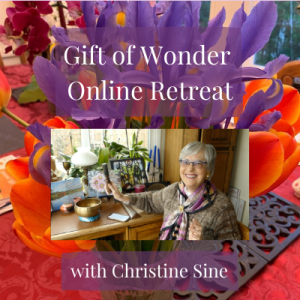
Gift of Wonder Online Retreat
Today I am posting real treat of contemplative services in addition to the usual contemplative service from St Andrews .
As many of us continue to struggle with our pain and the pain of others, we feel the call to lament. The Many, an indie, intentionally diverse music collective from Chicago singing music of faith and doubt, hope and lament sing new songs made for reflection, for protest, for healing and worship. Together, this unique group of musicians, songwriters, poets, activists, uneasy prophets and unsaintly saints, remind us over and over again that we aren’t alone, that God so loves every one of us, and we all belong here.
Every Wednesday, they are making space for people to grieve losses and name the sorrows we’re all walking through with this pandemic, as well as find community and possibly even some things to be grateful for. I though that for this week’s contemplative service that you might enjoy this service This service, which was posted on June 17th is an example of the good work that they do. Enjoy
Here is the Taize style contemplative service from St Andrews Episcopal Church in Seattle with Carrie Grace Littauer, prayer leader, with music by Kester Limner and Andy Myers.
I am also posting a Taize song from St Andrews Episcopal Church in Seattle sung by Kester Limner and Andy Myers
Nada te Turbe, nada te espante
Qien a Dios tiene, nada le falta
Nada te turbe, nada te espante
Solo Dios basta
(Nothing can trouble, nothing can frighten
Those who seek God shall never go wanting
Nothing can trouble, nothing can frighten
God alone fills us
Todo se pasa, Dios no se muda;
La paciencia todo lo alcanza.
(Everything passes, God does not change,
With patience all shall be won)
En Cristo mi confianza,
y de El solo mi asimiento,
en sus cansacios mi aliento,
y en su imitacion mi hoganza.
(In Christ is my confidence,
And in Him only is my affection,
In whom my breath shall rest,
and my hope is to be his likeness)
Aqu estriba mi firmeza,
aqui mi seguridad,
la preba de mi verdad,
la muestra di mi firmeza.
(Here is my steadfastness,
Here is my safety,
the proof of my truth,
and testament of my faith)
Copyright and all rights reserved by GIA/Les Presses de Taizé Permission to podcast/stream the music in this service obtained from One License with license #A-710-756.
Ever since I worked with refugees in the mid 80s, those who are displaced from their homes by war and violence have held a special place in my heart. Because I feel so deeply about this, it has been hard for me to write, but there are others who have written very eloquently from a Christian perspective that you might be interested in.
The following, I think, are must read articles:
Craig Greenfield’s post: Jesus Was A Refugee
Pope Francis’ call to Catholic congregations to shelter Syrian refugees.
And if you are looking for a way to respond check out “We Welcome Refugees” and the UNHCR website.

photo by Jennifer Hamlett Herrick
The plight of 70.8 million refugees hangs in the balance and we can make a difference. Why not start by saying this prayer from our good friend, John Birch?

by Kate Kennington Steer – (All images by Kate Kennington Steer)
I am drawn to light, of all kinds, in all shapes. I am pulled towards the symbols and manifestations of the Great Light. And yet, paradoxically, through chronic ill health, I am often dragged into the most shadowed places within. The darknesses of depression are a constant companion lurking not far from my surface, but this very presence of darkness also provides a constant metaphor for my seeking of the Holy. I long to behold the face of God in these places where, as Barbara Taylor Brown summarises, ‘Dark is not Dark to God’. Over the years it has become clear that in order to examine the nature of Light I often need to stand still in a place of contrasting, but corresponding, shadow.
As I come to the time in the annual calendar when I can join the millions reaching back down the centuries to mark this summer’s Solstice, I find myself contemplating how the roots of the word ‘solstice’ might illuminate a continued Covid-19 lockdown for my parents and I, as we continue to shield one another. Solstice is derived from the Latin root words sol (Sun) and sistere (to stand still). As a contemplative photographer, Sol is often my sole subject, as I play with perceptions of things others often overlook, as I draw attention to the revelation of Joy in a colour, or Peace in a shape. I seek out the places where, in my own immediate context, the Sun has made herself visible, and by Grace, can be encountered in the shrivelling of a leaf as much as in the blooming of a daylily.
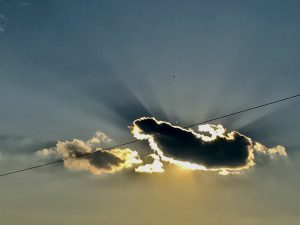
photo by Kate Kennington Steer
Just as over the last few years I have learnt to welcome and accept the gifts of midwinter through celebrating the winter Solstice, the shortest day, as ‘Blue Christmas’, so I am aware of a balancing need to recalibrate my appreciation of the longest day. Noticing how light passes by and through me when the earth’s axial tilt towards the sun is at its greatest (in relation to the northern hemisphere), is not something to which I normally consciously remember to pay attention. Perhaps this is because I associate the summer Solstice so strongly with seeing the dawn, and normally, seeing dawn is problematic for me. Dawn is indicative of the fact I haven’t been able to sleep and is a sign of a rough day ahead, rather than what I long for it to be: a purposeful invitation to rise up with energy to enter the new day’s beginning.
I have long been fascinated by the mystery of Solstice rituals and myths surrounding Stonehenge, awed by ancient practices and connections. I am drawn towards the idea of celebrating seasonal cycles, and making my own thanksgiving rites so that I do not take the sun’s blessing on the earth for granted. Stonehenge’s alignment of certain stones in certain lights at particular moments of the year offers a thread of connection back to my Neolithic ancestors who seem to have been drawn to the place as a sacred spot to honour their ancestors in their turn. I am drawn towards the stones themselves, particularly those which literally become ‘ringing rocks’, mined in the far west of Wales, a land where some of my own ancestors were born. These Welsh ‘bluestones’ have old legends of healing attached to their peculiar acoustic properties, so it’s not difficult for me to make imaginative leaps, seeing how varying ritual alignments of light might bring shifts in meaning through thanksgiving to healing to blessing. For obvious reasons, being healed by the Shining One is one of my prayers of longing.
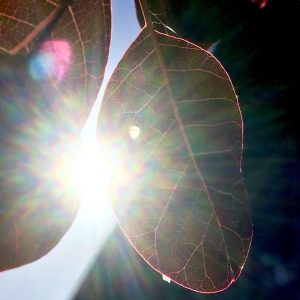
photo by Kate Kennington Steer
As I wrote at Beltane, the metaphor of fire has kept cropping up for me throughout the Resurrection season so perhaps this year, if I cannot get up at sunrise, I might join in with another Solstice tradition and light a fire at sunset? Hildegard of Bingen saw fire as the element associated with the South, and so with abundance, with energy, with power, with passion, and ripening. Fire could be the prompt I need to align myself with these qualities in this season of my life.
By conflating the Pagan and Christian calendars, marking Solstice (21/22 June) as the celebration of the start of summer, often became confused with St John’s Day (24 June), which marked Midsummer. During the Medieval period in England a ritual of lighting three ‘St John’s fires’ became popular, with one of these being a huge burning wheel, which was rolled downhill in a dramatic demonstration symbolising the sun’s turning. The festivities using light and fire on St John’s Eve marked the counterpoint to those used on Christmas Eve, making literal links between the birth of John the Baptist and the birth of Christ the Light-bringer, six months later (25 December).
So my Solstice celebration this year might act like a plumb line dropped through history; across space and time my stillness might join with that of others before the Light of the World. Solstice might present an opportunity for me to align myself anew, so that the dawn might brighten my soul, so that the midday might give me strength in its blazing.
In the fiery heat of summer, how may I fan my kindled flames into passionate outpourings? How might my small store of energy be amplified by the power of the Light which is infinite? How might I allow this abundant Light to flow through me, to overflow for the good of those around me?
As I stand on the threshold of summer, the season of slow ripening, may I raise my face to absorb God’s Glory. As I encounter the Creator, may I bow down, aligning my whole body with God’s Will. As I am raised up by Grace once again, may I rise impassioned and envisioned, filled with light distilled from shadow, ready to serve and ready to bless:
The Lord bless you and keep you
the Lord make his face to shine upon you, and be gracious to you
the Lord lift up his countenance upon you and give you peace.
(Numbers 6.24-5 NRSV)

photo by Kate Kennington Steer
As an Amazon Associate, I receive a small amount for purchases made through appropriate links.
Thank you for supporting Godspace in this way.
When referencing or quoting Godspace Light, please be sure to include the Author (Christine Sine unless otherwise noted), the Title of the article or resource, the Source link where appropriate, and ©Godspacelight.com. Thank you!

